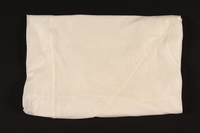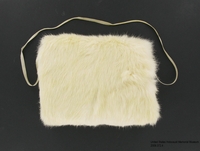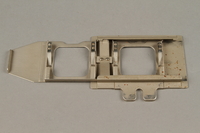Overview
- Brief Narrative
- White rabbit fur bonnet worn by two year old Alice Robinson, in the Zeilsheim displaced persons camp in Germany, where she lived from 1945-1948. Alice's parents, Ephraim and Sarah had left Poland soon after September 1939, when it is occupied by Nazi Germany. They fled east to Russian controlled territory where the Soviet Union demanded that Jewish refugees keep moving further east. They had a daughter, Fay, in 1941, in Odessa, and Alice was born in 1944 in Romanovka. When the war ended in May 1945, they returned from Uzbekistan to Bessarabia, where they crossed the border to Poland. In October 1945, they were relocated to Zeilsheim, with the assistance of the Hebrew Immigrant Aid Society. Ephraim, Sarah, and their 3 children, Fay, Alice, and Joseph, born in the camp in 1946, got passage on the first immigrant transport to depart under the Displaced Persons Act, the SS General Black, which arrived in the United States on October 30, 1948.
- Date
-
received:
1948
emigration: 1948 October 21
- Geography
-
use:
Zeilsheim (Displaced persons camp);
Zeilsheim (Frankfurt am Main, Germany)
- Credit Line
- United States Holocaust Memorial Museum Collection, Gift of Alice Robinson Lev
- Contributor
-
Subject:
Alice R. Lev
- Biography
-
Henia Rubinzon (later Alice Lev, b. 1945) was born to Efraim (later Ephraim Robinson, 1915-1985) and Sara Shpigel Ghingis (later Sarah Robinson, 1916-1984) Rubinzon in Romanovka (now Basarabeasca, Moldova), in a region known historically as Bessarabia. Following World War I (1914-1918), the region, formerly part of the Russian Empire, became part of Romania. Henia had an older half-sister, Fania (later Fay Shlimovitz ,1941-2002) and a younger brother, Joseph (later Robinson, b. 1946). Henia’s father, Efraim, was a trained agronomist who specialized in dairy. Efraim was from Warsaw, Poland, where his family sold imported perfumes and cosmetics in a store below their home. Henia’s mother, Sara, was originally from Romanovka, and had a large, extended family.
Efraim was in Warsaw with his mother and brother, following his father’s death, when Germany invaded Poland on September 1, 1939. Germany began bombing Warsaw daily, and an incendiary bomb destroyed the family’s apartment and store. Later that fall, German soldiers came looking for Efraim because he had a French passport from the prior year, when he studied agronomy and worked at a dairy in France. He escaped and fled alone to Soviet-controlled territory near Bialystok, Poland, and then the Donbas region (now in Ukraine). By the time he was able to obtain travel papers for his mother and brother, they were imprisoned in the Warsaw ghetto and later died.
Efraim convinced Soviet authorities that his French degree in agronomy was useful on a farm than in a coal mine, and he was put to work on collective farms throughout the western Soviet Union. During this time, Efraim met recently widowed Sara Shpigel Ghingis on a sovchoz [collective farm] near Tashkent (now Uzbekistan). Sara and several relatives had fled from Romanovka one day before it was invaded by German forces in July 1941. During her flight, Sara gave birth to Henia’s sister, Fania, in Novaya Odessa (now Nova Odesa, Ukraine). They continued fleeing eastward until they reached Tashkent. In 1943, Sara learned that her husband, Chaim Ghingis (1916-1941?), had died fighting in Stalingrad.
Efraim and Sara married at city hall on March 3, 1944, and Efraim adopted Fania. The family was still near Tashkent when the Soviets drove German forces out of the region in 1944. All refugees there were told to return to their places of origin. Efraim did not want to return to Warsaw, so the Rubinzon family then made their way to Sara’s hometown, Romanovka. They arrived there in December 1944, after a six-week train journey. They lived with several of Sara’s surviving relatives in the home of Nachman Rapoport, her maternal grandfather. These were relatives that had initially fled with her and returned just before the Rubinzons. Any relatives that had not fled had been killed. Following the Soviet return to the region in 1944, the area was renamed the Moldavian Soviet Socialist Republic. The Rubinzon family was living there when Henia was born in February 1945. The war ended in Europe that May.
Efraim oversaw milk and cheese production at a nearby dairy where the workers did not earn enough, due to rampant corruption. He faced mounting pressure to alter production records so the workers could steal food to feed their families. If Efraim gave into their pressure, he knew he could end up in a gulag in Siberia. He decided it was time to leave the region, and in August, he bribed a farmer with bottles of vodka to smuggle his family out of the country. The farmer got the family across the border in two trucks, likely into Soviet-occupied Romania. Once over the border, Jewish agents helped the family continue their escape. That October, the Rubinzon family was sent to Zeilsheim displaced persons camp in Germany with the assistance of the Hebrew Immigrant Aid Society (HIAS). Zeilsheim was operated by UNRRA (United Nations Refugee Relief Administration). While at the camp, Efraim worked as a photographer, taking hundreds of photographs of camp life. Henia’s brother, Joseph (b.1946), was born in Zeilsheim.
Efraim wished to relocate to Palestine, but that was not possible because the British closed the borders to Jewish immigrants. For a time, there were plans to smuggle the family members in individually, but they did not want to be separated. Henia’s father was able to send word to his relatives in the United States to explain that he had survived. He was the only member of his family to survive the Holocaust, and his relatives wanted his family to join them in the US. They sent the Rubinzon family immigration papers, so Efraim, Sara, Henia, Fania, and Joseph booked passage on the USAT General W. M. Black from Bremerhaven on October 21, 1948. The family arrived in New York City on October 30.
Efraim thought that, due to his training, he would do better in “the Dairy State”, so the family settled in Milwaukee, Wisconsin. They anglicized their surname to Robinson, and Efraim and Sara also anglicized their first names to Ephraim and Sarah. Henia changed her name to Alice and Fania became Fay (Ghingis-Robinson). Ephraim worked for several companies, and in 1950, he became an independent livestock dealer. Around 1968, he became a real estate broker and opened Blue Ribbon Realty with two partners. On July 7, 1967, Alice married Abraham David Lev (Abby, b. 1944), had children, and settled in California. In 1965, Fay married Dr. Alan Shlimovitz (1941-2020) and the couple later had children. Joseph settled in Los Angeles, California. In 1995, a selection of Ephraim’s photographs of Zeilsheim were published as Das Album von Ephraim Robinson: jüdische Überlebende in DP-Lagern im Nachkriegsdeutschland (Ephraim Robinson's album: Jewish survivors in DP camps in post-war Germany).
Physical Details
- Classification
-
Dress Accessories
- Category
-
Headgear
- Object Type
-
Hats (lcsh)
- Physical Description
- White rabbit fur, squarish bonnet with 2 ear flaps and long, synthetic cords that tie under the chin. The inside is lined with a quilted, diamond patterned, offwhite cloth.
- Dimensions
- overall: Height: 8.750 inches (22.225 cm) | Width: 8.500 inches (21.59 cm)
- Materials
- overall : fur, cloth, cord
Rights & Restrictions
- Conditions on Access
- No restrictions on access
- Conditions on Use
- No restrictions on use
Keywords & Subjects
Administrative Notes
- Legal Status
- Permanent Collection
- Provenance
- The bonnet was donated to the United States Holocaust Memorial Museum in 2009 by Alice Robinson Lev, the daughter of Ephraim and Sarah Robinson.
- Record last modified:
- 2023-08-14 10:55:28
- This page:
- https://collections.ushmm.org/search/catalog/irn40085
Download & Licensing
In-Person Research
- By Appointment
- Request 21 Days in Advance of Visit
- Plan a Research Visit
- Request to See This Object
Contact Us
Also in Ephraim Robinson family collection
The collection consists of children's clothing, a duvet cover, a glass slide projector, glass slides, and a photograph album relating to the experiences of Ephraim Robinson and his family as refugees during the Holocaust, as residents of Zeilsheim displaced persons camp in Germany, and as immigrants to the United States in the postwar period.
Date: 1945-1948

Duvet cover made from a US Army parachute by a Jewish family in a displaced persons camp
Object
Covering for a blanket made from a United States Army parachute by Ephraim and Sarah Robinson for their family in the Zeilsheim displaced persons camp in Germany, where they lived from 1945-1948. Soon after Nazi Germany invaded Poland in September 1939, Ephraim and Sarah fled east to Russian controlled territory. They lived in several places as the Soviet Union demanded that Jewish refugees keep moving further east. They had a daughter, Fay, in 1941, in Odessa, and Alice was born in 1944 in Romanovka. When the war ended in May 1945, they returned from Uzbekistan to Bessarabia, where they crossed the border to Poland. In October 1945, they were relocated to Zeilsheim, with the assistance of the Hebrew Immigrant Aid Society. Ephraim, Sarah, and their 3 children, Fay, Alice, and Joseph, born in the camp in 1946, got passage on the first immigrant transport to depart under the Displaced Persons Act, the SS General Black, which arrived in the United States on October 30, 1948.

Child's white rabbit fur hand muff received in a displaced persons camp
Object
White rabbit fur hand muff worn by Alice Robinson, age 2, in the Zeilsheim displaced persons camp in Germany, where she lived from 1945-1948.Alice's parents, Ephraim and Sarah had left Poland soon after September 1939, when it is occupied by Nazi Germany. They fled east to Russian controlled territory where the Soviet Union demanded that Jewish refugees keep moving further east. They had a daughter, Fay, in 1941, in Odessa, and Alice was born in 1944 in Romanovka. When the war ended in May 1945, they returned from Uzbekistan to Bessarabia, where they crossed the border to Poland. In October 1945, they were relocated to Zeilsheim, with the assistance of the Hebrew Immigrant Aid Society. Ephraim, Sarah, and their 3 children, Fay, Alice, and Joseph, born in the camp in 1946, got passage on the first immigrant transport to depart under the Displaced Persons Act, the SS General Black, which arrived in the United States on October 30, 1948.

Leitz glass slide projector with case, trays, and key ring used in a displaced persons camp
Object
Leitz projector for glass slides with case, trays, and a key ring used by Ephraim Mayer Robinson to view photographs that he took of activities in Zeilsheim displaced persons camp in Germany from 1945-1948. Soon after Nazi Germany invaded Poland in September 1939, Ephraim and his wife, Sarah, fled east to Soviet territory. They relocated often as the Soviet Union demanded that Jewish refugees keep moving further east. They had a daughter, Fay, in 1941, in Odessa, and Alice was born in 1944 in Romanovka, Bessarabia. When the war ended in May 1945, they returned from Uzbekistan to Bessarabia, where they crossed the border to Poland. In October 1945, they were relocated to Zeilsheim, with the assistance of the Hebrew Immigrant Aid Society. Ephraim, Sarah, and their 3 children, Fay, Alice, and Joseph, born in the camp in 1946, got passage on the first immigrant transport to depart under the Displaced Persons Act, the SS General Black, which arrived in the United States on October 30, 1948.

Ephraim Robinson color slides
Document
Collection of materials documenting the experiences of the Robinson family in the Zeilsheim Displaced Persons (DP) camp and after their immigration to the United States in October 1948. The collection includes: a photo album compiled by Ephraim Robinson of the Zeilsheim DP camp, Agfacolor 35mm color film transparencies in a wooden box taken by Ephraim Robinson of the Zeilsheim DP camp and in Milwaukee, Wisconsin, slide projector brought by Ephraim Robinson from Germany to the United States, a duvet cover made from an American parachute, and a rabbit fur hat and muff worn by Alice Robinson in the Zeilsheim DP camp; collection dated 1945-1948.
Ephraim Robinson photograph album
Document
Collection of materials documenting the experiences of the Robinson family in the Zeilsheim Displaced Persons (DP) camp and after their immigration to the United States in October 1948. The collection includes a photo album compiled by Ephraim Robinson of the Zeilsheim DP camp.



